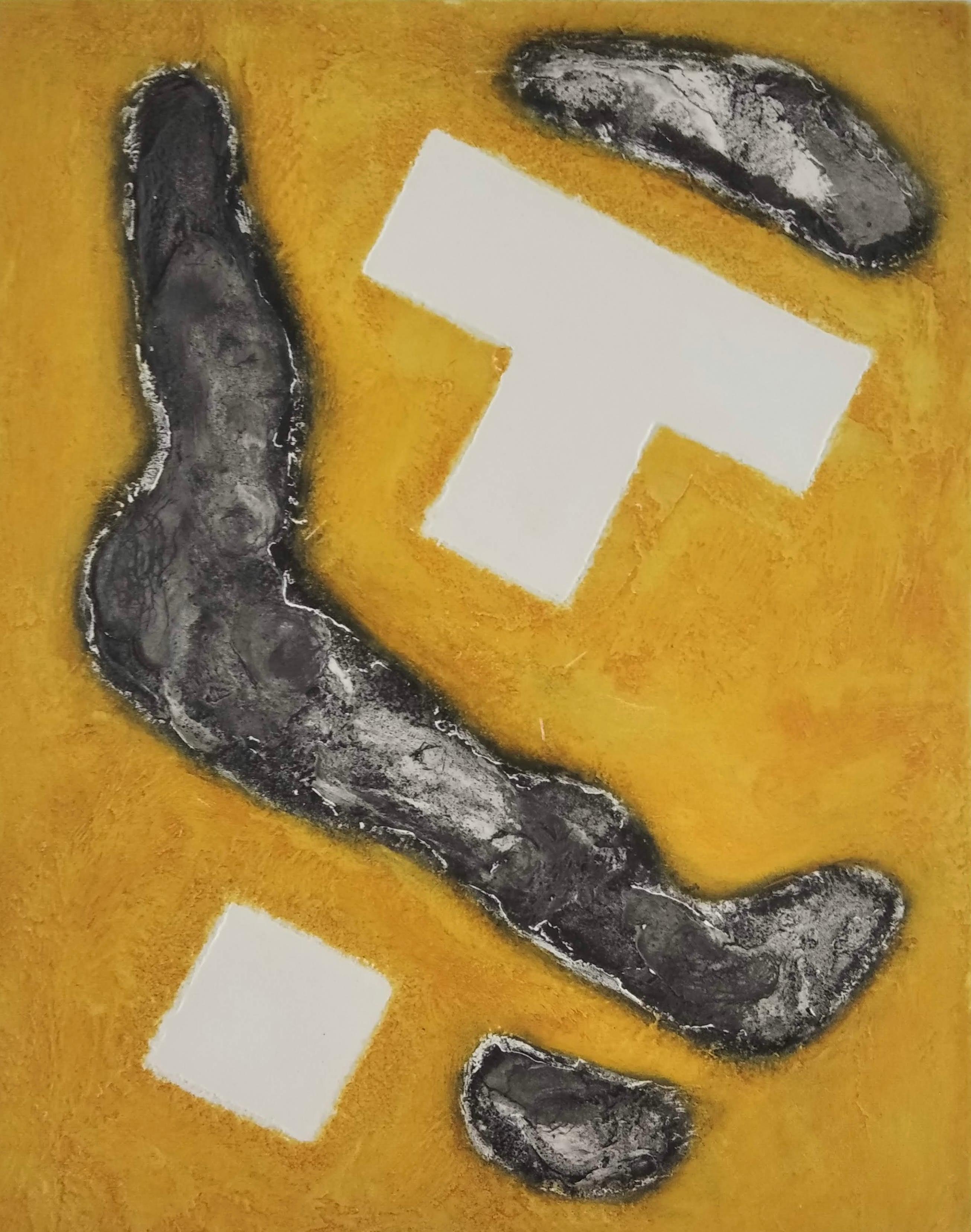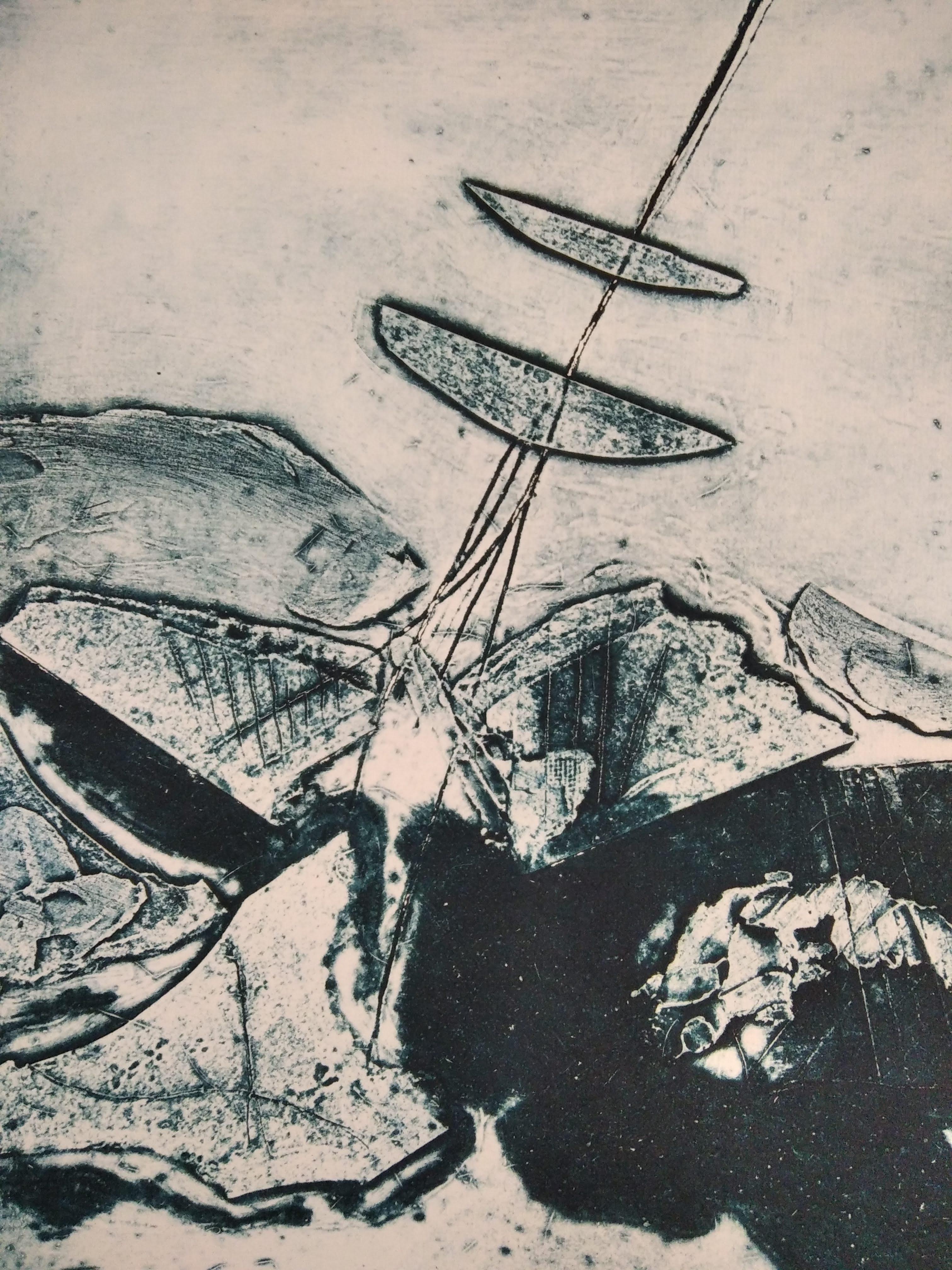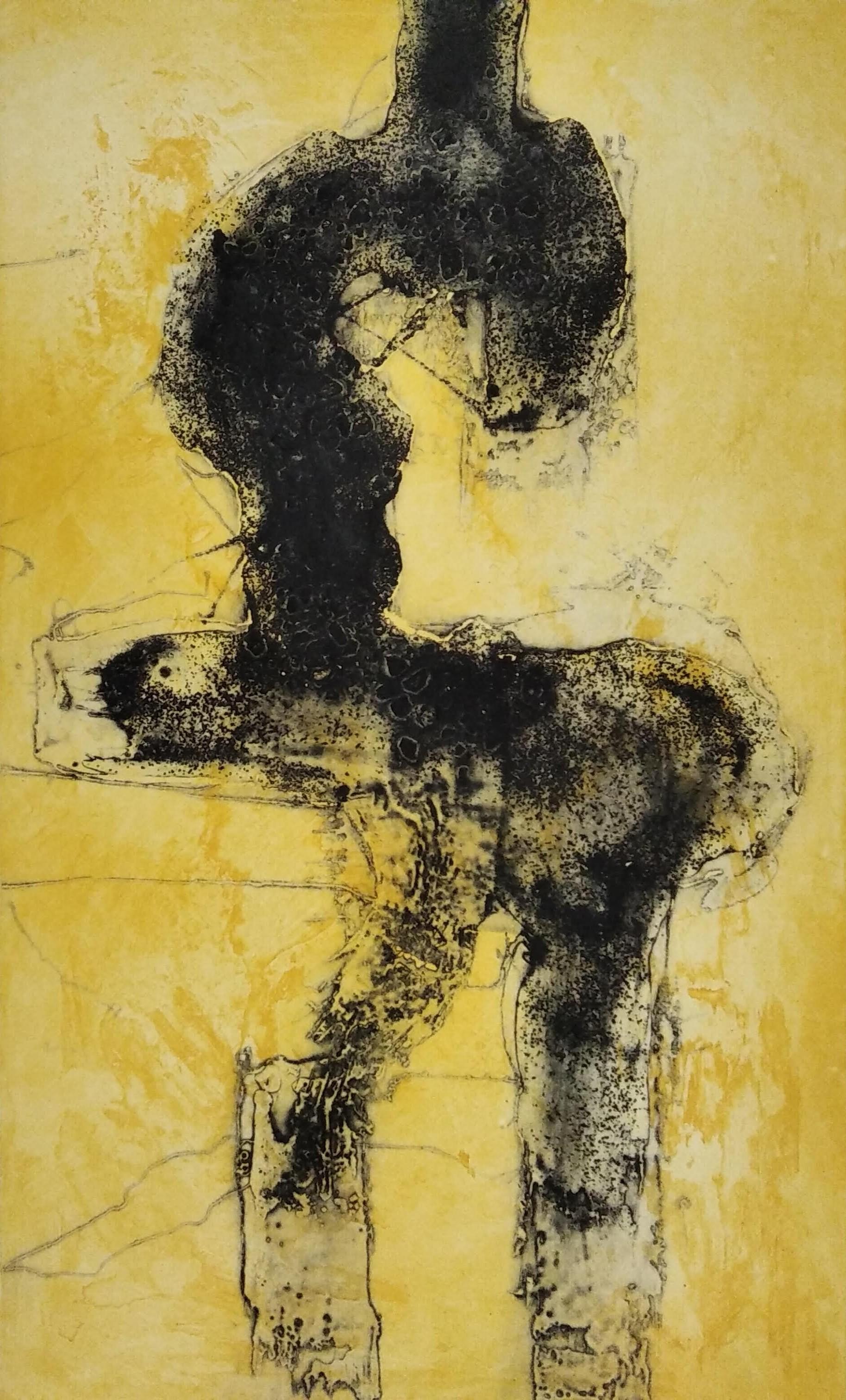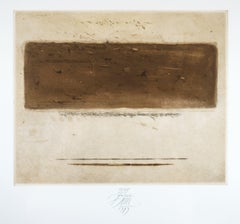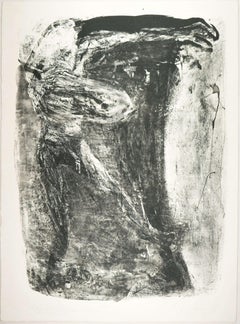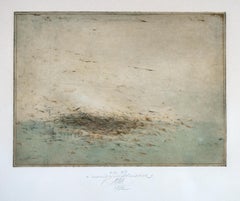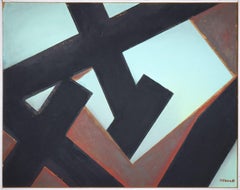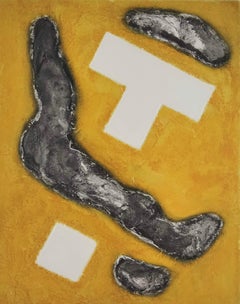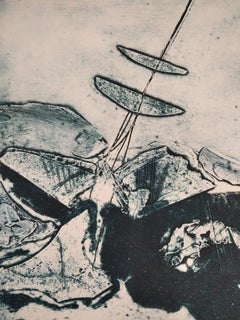Items Similar to Untitled / - The archaism of nature -
Want more images or videos?
Request additional images or videos from the seller
1 of 8
Jorge MacholdUntitled / - The archaism of nature -1973
1973
$260.82
£198.19
€220
CA$366.02
A$399.11
CHF 207.44
MX$4,777.91
NOK 2,631.15
SEK 2,464.57
DKK 1,675.98
About the Item
Jorge Machold (1940 Chemnitz - 2015 Berlin), Untitled, 1973. Color etching, 41.5 x 29.2 cm (plate size), 49.5 cm x 39.5 cm (sheet size), signed lower right in lead “J.[orge] Machold” and dated “[19]73”, identified lower left as copy no. 11/150.
- Minimal foxing and darkening outside the image, the lateral margins with mounting residue on the reverse
- The archaism of nature -
Against a black background, an amorphous, seemingly naturally grown structure reminiscent of sand and stone appears. A gap roughly bisects it, making the two resulting parts appear like the limbs of a bone. However, because the form cannot be dissolved, it exhibits a primal quality, preceding concrete natural forms. It does not stand out from the black background, but rather, it is connected to it by its similar structure.
About the artist
After completing an apprenticeship as a mold maker in a foundry and receiving technical training as a designer, Jorge Machold moved to Frankfurt am Main in 1959 and started his career as an artist. In 1964, he relocated to West Berlin. After his first solo exhibition at the Biibobh Gallery in 1967, he devoted himself exclusively to art. Inspired by Antoni Tàpies, Eduardo Chillida, and Mark Tobey, Machold developed a style of abstraction linked to nature. Throughout his multifaceted body of work, he repeatedly experimented with surface structure design in his embossed prints and monumental sculptures. For these pieces, he used dissolved metals, giving them a grown appearance. In addition to the studio he moved into in 1976 in the tower of the former Zeiss-Goerz factory in Berlin-Friedenau, Machold opened a second studio in the Lüchow-Dannenberg district. The extensive garden of this studio was increasingly transformed into a sculpture park. Trips to Japan, Iceland, the Sahara, and the Atlas Mountains provided new experiences with nature and culture that he incorporated into his work.
Throughout his career, Machold's works were shown in solo exhibitions and at major international art fairs. In 2008, the art collections of his hometown of Chemnitz organized a major retrospective of his work.
GERMAN VERSION
Jorge Machold (1940 Chemnitz - 2015 Berlin), Ohne Titel, 1973. Farbradierung, 41,5 x 29,2 cm (Plattengröße), 49,5 cm x 39,5 cm (Blattgröße), rechts unten in Blei mit „J.[orge] Machold“ signiert und auf „[19]73“ datiert, linke unten als Exemplar Nr. 11/150 ausgewiesen.
- außerhalb der Darstellung minimal stockfleckig und nachgedunkelt, die seitlichen Ränder rückseitig mit Montageresten
- Die Archaik der Natur -
Vor einem schwarzen Grund erscheint eine amorphe wie natürlich gewachsen wirkende, gleichermaßen an Sand wie an Steine erinnernde Struktur. Sie wird, etwa mittig, von einem Spalt durchzogen, der die beiden dadurch entstehenden Teile wiederum wie Glieder eines Knochens erscheinen lässt. Indem sich die Form aber gerade nicht auflösen lässt, weist sie etwas Urtümliches, den konkreten Naturformen Vorgängiges auf. Dabei hebt sie sich nicht vom schwarzen Grund ab, sondern ist durch die ganz ähnliche Strukturierung des Grundes mit diesem verbunden.
zum Künstler
Nach einer Lehre als Formbildner in einer Gießerei und einer technischen Ausbildung zum Konstrukteur zog Jorge Machold 1959 nach Frankfurt am Main und begann sich künstlerisch zu betätigen. 1964 siedelte er nach West-Berlin um und widmete sich nach seiner ersten Einzelausstellung in der Galerie biibobh, 1967, ausschließlich der Kunst. Inspiriert von Antoni Tàpies, Eduardo Chillida und Mark Tobey entwickelte er eine an die Natur rückgebundene Abstraktion. Dabei experimentierte er innerhalb seines facettenreichen Werkes bei seinen Prägedrucken und den mitunter monumentalen Plastiken immer wieder mit der Gestaltung der Oberflächenstrukturen, für die er gelöste Metalle einsetzte, was den Werken einen gewachsenen Anschein verleiht. Neben seinem ab 1976 bezogenen Atelier im Turm des ehemaligen Zeiss-Goerz-Werkes in Berlin Friedenau eröffnete Machold Im Landkreis Lüchow-Dannenberg ein zweites Atelier, dessen weitläufiger Garten sich zusehends in einen Skulpturenpark verwandelte. Reisen nach Japan, Island, in die Sahara und das Atlasgebirge führten zu neuen Natur- und Kulturerfahrungen, die in sein Werk eingingen.
Über sein gesamtes Schaffen hinweg wurden Macholds Werke immer wieder in Einzelausstellung gezeigt und waren zudem auf den großen internationalen Kunstmessen präsent. 2008 veranstalteten die Kunstsammlungen seiner Heimatstadt Chemnitz eine große Retrospektive seines Oeuvres.
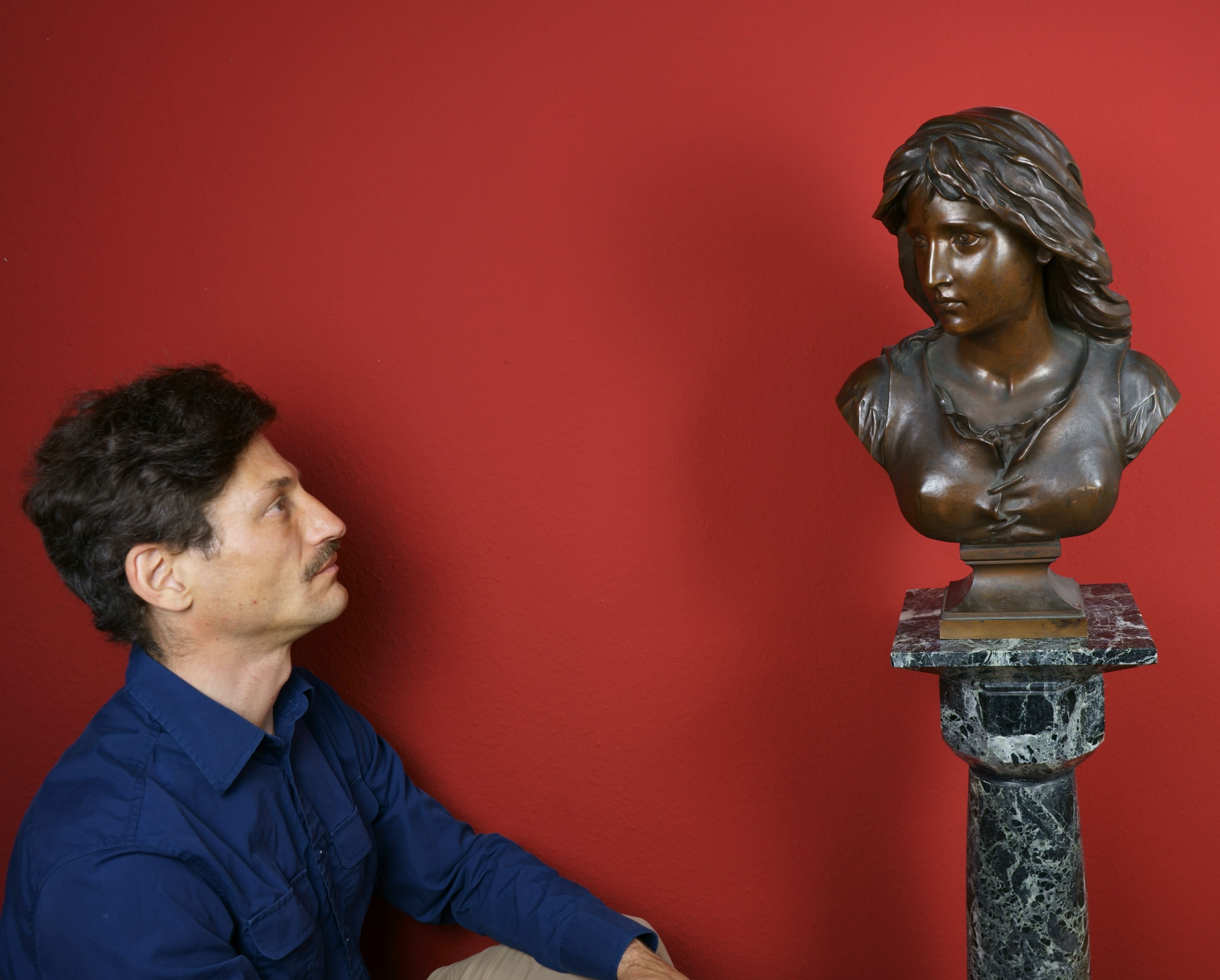
About the Seller
5.0
Vetted Professional Seller
Every seller passes strict standards for authenticity and reliability
Established in 2014
1stDibs seller since 2023
22 sales on 1stDibs
Typical response time: <1 hour
- ShippingRetrieving quote...Shipping from: Berlin, Germany
- Return Policy
More From This Seller
View AllField - Field research -
Located in Berlin, DE
Karl Ludwig Mordstein (1937 Füssen - 2006 Wilszhofen), Field 1983. Color etching, copy 13/65, 22.5 x 28 cm (image), 40 x 45 cm (sheet), 43 x 48 cm (frame), titled, numbered, monogram...
Category
1980s Abstract Abstract Prints
Materials
Etching
$426 Sale Price
20% Off
My treasure, my sanctuary / - A Tortured Treasure -
Located in Berlin, DE
Johannes Heisig (*1953 Leipzig), "My treasure, my sanctuary" - To the Christmas Oratorio by Johann Sebastian Bach. Lithograph on strong yellowish laid paper with watermark, 53 x 39.5...
Category
1980s Abstract Expressionist Figurative Prints
Materials
Lithograph
$360 Sale Price
20% Off
Indistinct Clear - Fluctuating ambivalence -
Located in Berlin, DE
Karl Ludwig Mordstein (1937 Füssen - 2006 Wilszhofen), Undeutlicher deutlich, 1982. Color etching, e.a. (Epreuve d'artiste) 4/9, 22.5 x 28 cm (image), 40 x 45 cm (sheet), 43 x 48 cm ...
Category
1980s Abstract Abstract Prints
Materials
Etching
$455 Sale Price
20% Off
Tectonic Tension / - Archetypes of Painting -
Located in Berlin, DE
Jürgen Möbius (*1939 Großenhain), Tectonic Tension. Oil on hardboard, 47.5 x 60 cm, 49 x 61.5 cm (frame), signed lower right "Möbius" and dated "[19]81".
- Upper left corner with a small chip, light scratches and a little rubbed in places. Provisional gallery frame with traces of use.
- Archetypes of Painting -
About the artwork
The form structure in front of the eye is overlapped by the frame. Thus, the frame does not open up a space in which something is presented, but rather shows the seemingly arbitrary section of a comprehensive context that cannot be framed as such.
We see forms that stand in a structure of tension with each other, whereby the individual black and brown forms, which continue almost endlessly beyond the frame, already show a tension in themselves, since they are not only forms, but also surfaces - form surfaces, while the light blue surface ground is at the same time forms that appear as surface forms. The formed surfaces and surface forms are nested within each other and form a structure that encompasses all elements.
The angular arrangement of the black and brown shaped surfaces gives the structure a tectonic character. The tension is thus heightened to the point of paradox, since the black shape at the front is overlapped by the brown shape at the bottom in the center of the picture, which would be impossible in real space. It is precisely through this "paradox" that Möbius demonstrates that the paradoxical is reality within painting. It is, so to speak, the most original possibility of painting, which distinguishes it from the other arts. In combination with the tectonic formations, Jürgen Möbius creates an archaic primordial painting, which, however, should not be confused with the autonomous color and form cosmos of Suprematism à la Kasimir Malevich. Instead of homogeneous, perfectly colored forms, here the colors are deliberately applied unevenly, and the light blue is mixed with the brown in a manner determined by the brushstroke. At the edges of the surface forms, the uneven application of paint allows the wood of the unprimed hardboard to show through. In this way, Möbius illustrates that we are dealing with a painting that has been created by an act of painting - an act, however, that takes hold of the original principles of painting and thus realizes painting as such.
About the artist
From 1959 to 1965 Jürgen Möbius studied painting at the University Institute for Art and Work Education in Mainz. He also studied philosophy and art history at the University of Mainz. Afterwards he worked as a freelance artist in Mainz.
At first, Möbius created material reliefs and installations, then, around 1974, he turned increasingly to conceptual art and added cinematic means. During this phase he wrote the manifesto-like essay "Principles of Supranatural Landscape" (1979).
From 1981 on, Möbius concentrated on painting and searched for artistic ways to "treat intellectual and sensual perception equally in the fusion of representational and abstract pictorial elements" (Wolfgang Zemter). He found inspiration on his study trips to Thailand and Sri Lanka.
"The pure painting of Jürgen Möbius flows through us as a timeless expression of memory and energy, ploughing our perception and bringing us the happiness of seeing authentic, immovable form.
- Philippe Büttner
Selection of solo exhibitions
1969 Galerie Würzner, Düsseldorf / Galerie Gurlitt, Mainz
1972 Städtische Galerie, Mainz
1973 Galerie Schloss Ringenberg Rathaus, Kleve
1974 Röderhausmuseum, Wuppertal
1976 Galerie Glasing, Osnabrück / Städtische Galerie, Herne
1977, 1997, 2004 Märkisches Museum, Witten
1979 Studio M, Bamberg / Staatstheater, Darmstadt
1980 Galerie Stolànovà, Wiesbaden / Mittelrheinmuseum, Koblenz
1982 Galerie Dornhöfer, Mainz
1984 Galerie Neumühle, Schlangenbad
1985 Landesmuseum, Mainz / Kunstverein, Ludwigshafen / Nassauischer Kunstverein, Wiesbaden
1986 Museum, Bochum / Galerie der Stadt Iserlohn
1987, 1990 Galerie Klaus Kiefer, Essen
1987, 2000 Galerie Ulrike Buschlinger, Wiesbaden
1988 Kunsthalle Darmstadt
1988, 1992, 1996, 1999 Galerie Leonhard, Basel
1992, 2002 Galerie Zulauf, Freisheim
1994 Galerie Remy, Vallendar
1995 Sendezentrum des Zweiten Deutschen Fernsehens, Mainz
2001 Collegium oecumenicum, Bamberg / MVB Forum für Kultur und Wirtschaft, Mainz
2006 Adam Gallery, London
Selection of group exhibitions
1969 ‘International Graphic Arts’, Galerie Dalléas Bordeaux, Paris
1975 ‘Deutscher Künstler-Bund’, Dortmund
1979 ‘Man and man’s Images’, Märkisches Museum Witten
1980 ‘Love-Dokuments of our Time’, Art Hall Darmstadt and Art Association Hannover
1982 ‘Work - Progress – Position’, Nassau Art Association Wiesbaden
1983 ‘Principle Hope – Utopic Aspects in Art and Culture of the 20th Century’, Museum Bochum
1986 ‘Selfportraits’, Gallery Klaus Kiefer Essen
1987 ‘The Dying and Death’, Gallery Klaus Kiefer Essen
1989 ‘Where are You, Revolution – Freedom, Liberty, Egality, Fraternity to-day’, Museum Bochum 1990 ‘Flight – a Problem within the Memory of Man’, Kunsthalle Darmstadt ‘Art and War 1939 – 89’, House of Cultures Berlin
1991 ‘Material and Form’, Pillnitz Castle Dresden and Pfalz Gallery Kaiserslautern
1995 20 Years Exhibitions, Chrämerhuus Langenthal, Schweiz
1998 ‘Works on Paper’, Klaus Kiefer Gallery Essen
2000 ‘Acquisitions 1900 – 2000’, Mittelrhein-Museum Koblenz
2001 ‘Strange Pictures’, Klaus Kiefer Gallery Essen
2002 ‘10 Years Buschlinger Gallery’, Buschlinger Gallery Wiesbaden
2004 ‘Eternal Space – Pictures and Sculptures’, Dome of Bamberg
2005 Art Fair Chicago, Adam Gallery, London
Selected Bibliography
Mittelrheinisches Landesmuseum (Hrsg.): Jürgen Möbius - Neue Bilder, Mainz 1985.
Kunstverein Darmstadt (Hrsg.): Jürgen Möbius. Bilder 1985 - 1988. Kunsthalle Darmstadt, 26. Juni - 14. August 1988. Red. Dorit Marhenke, Lyrik Marcus Schiltenwolf, Düsseldorf 1988.
Gabriele Prusko (Hrsg.): Jürgen Möbius. Mit Texten von Philippe Büttner und Ralph Mieritz, Basel 1992.
Wolfgang Zemter (Hrsg.): Jürgen Möbius - Aktuelle Arbeiten. Märkisches Museum der Stadt Witten, Bönen 1999.
Wolfgang Zemter (Hrsg.): Jürgen Möbius. Flieger in meinem Zimmer und Beruhigte Zone, Bönen 2004.
Dama Gallery...
Category
1980s Abstract Abstract Paintings
Materials
Oil
$1,327 Sale Price
20% Off
Untitled / - Association -
Located in Berlin, DE
Detlef Baltrock (*1954 Stuttgart), Untitled, 1985. Watercolor, 29.5 cm x 21 cm (visible dimensions), 41 cm x 32 cm (frame), signed “Baltrock” lower center and signed “[19]85”, label ...
Category
1980s Abstract Expressionist Abstract Drawings and Watercolors
Materials
Paper
Untitled / - Bleeding Picture -
Located in Berlin, DE
Ouhi Cha (*1945 Busan), Untitled, 1988. mixed media, 31.8 cm x 23.3 cm (sheet size), signed “Ouhi Cha” in pencil below and dated “[19]88”.
- in good condition
- Bleeding Picture -...
Category
1980s Abstract Abstract Drawings and Watercolors
Materials
Paper
You May Also Like
Untitled
Located in Barcelona, BARCELONA
The painting is being offered with a work and authenticity certificate
Category
1980s Abstract Abstract Prints
Materials
Engraving
Untitled #1
Located in San Francisco, CA
This artwork, Untitled #1 is an original color aquatint on Wove paper by noted Mexican artist Luis Lopez Loza, b.1939. It is hand signed and numbered 4/50 i...
Category
Late 20th Century Abstract Abstract Prints
Materials
Aquatint
Untitled
Located in Barcelona, BARCELONA
the painting is being offered with a work and authenticity certificate
Category
1980s Abstract Prints
Materials
Engraving
Untitled #2
Located in San Francisco, CA
This artwork "Untitled #2" is a colors monotype on Arches paper by Dutch artist Frans Horbach. It is hand signed and dated in pencil by the artist. The image (plate mark) is 19.5 x 15.5 inches, sheet size is 30 x 22.25 inches. It is in excellent condition, the colors are fresh and bright, has never been framed.
About the artist:
Born in Holland, Dutch artist Frans Horbach first visited New York when he was 17 years old, traveling on a cargo ship from Rotterdam, just as his fellow country man Willem de Kooning had done years before. Two years later he left Holland and emigrated to California.
During the years that he lived and worked as a professional artist in America, one of the main sources of artistic influence came from artists belonging to what is now known as the New York school of American lyrical abstract expressionist art - Rothko, Pollock, De Kooning... He was attracted by their ideas, style of work, and more importantly, by their vital energy and uninhibited self-confidence.
Horbach's work also was influenced, more subtely perhaps, by his contact with indigeneous Indian people during his journeys in the American South-West and Mexico. These encounters were a rich source of inspiration - they became integral to a philosophical framework which involved the appreciation of physical space in a poetic and artistic sense. In later years, as the result of his long-time interest in oriental art and philosophy, some of his work show a distinct affinity with the aesthetic sensibilities of traditional Japanse...
Category
Late 20th Century Abstract Abstract Prints
Materials
Monotype
Untitled #1
Located in San Francisco, CA
This artwork "Untitled #1" is a colors monotype on Arches paper by Dutch artist Frans Horbach. It is hand signed and dated in pencil by the artist. The image (plate mark) is 19.65 x 19.65 inches, sheet size is 35.5 x 24.75 inches. It is in excellent condition, the colors are fresh and bright, has never been framed.
About the artist:
Born in Holland, Dutch artist Frans Horbach first visited New York when he was 17 years old, traveling on a cargo ship from Rotterdam, just as his fellow country man Willem de Kooning had done years before. Two years later he left Holland and emigrated to California.
During the years that he lived and worked as a professional artist in America, one of the main sources of artistic influence came from artists belonging to what is now known as the New York school of American lyrical abstract expressionist art - Rothko, Pollock, De Kooning... He was attracted by their ideas, style of work, and more importantly, by their vital energy and uninhibited self-confidence.
Horbach's work also was influenced, more subtely perhaps, by his contact with indigeneous Indian people during his journeys in the American South-West and Mexico. These encounters were a rich source of inspiration - they became integral to a philosophical framework which involved the appreciation of physical space in a poetic and artistic sense. In later years, as the result of his long-time interest in oriental art and philosophy, some of his work show a distinct affinity with the aesthetic sensibilities of traditional Japanse...
Category
Late 20th Century Abstract Abstract Prints
Materials
Monotype
Untitled
Located in Barcelona, BARCELONA
The painting is being offered with a work and authenticity certificate
Category
1980s Abstract Abstract Prints
Materials
Engraving
More Ways To Browse
Picasso Pomme
Pierre Soulages On Sale
Poems Dans Le Ciel
Quarry Robert Rauschenberg
Rafael Soriano
Richard Serra Etching
Richter P19
Robert Indiana 1968
Robert Indiana Signed Hope
Roderick Mead
Roger Nellens
Ron Adams
Rothko Signed Prints
Roy Lichtenstein Apple
Shorewood Reproductions
St Louis Symphony
Stella Frank Plates
Swan Engraving
